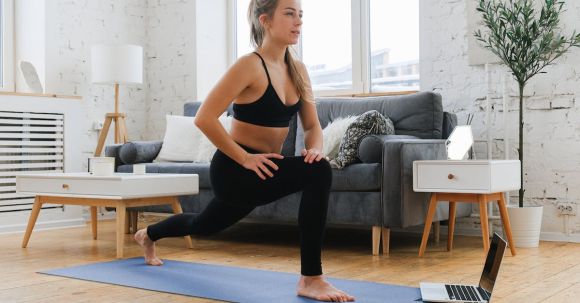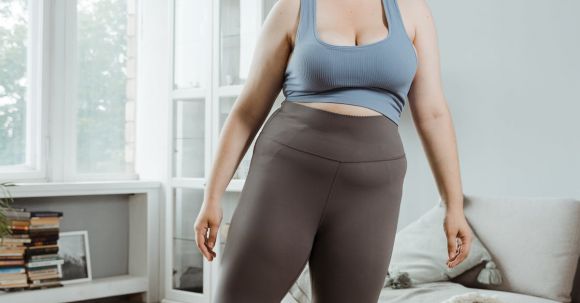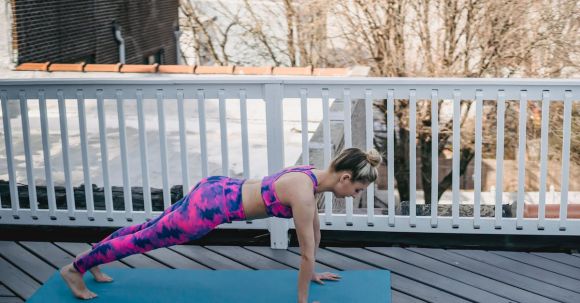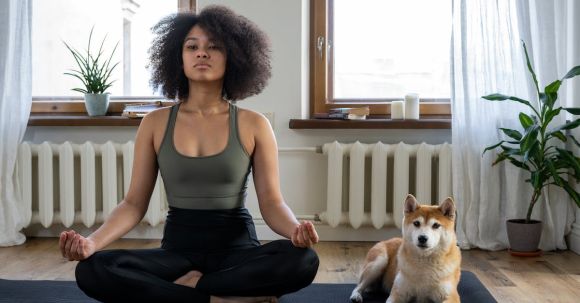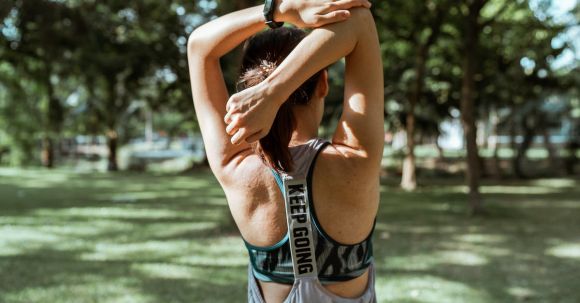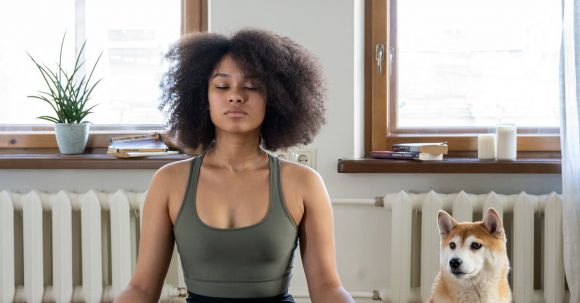In today's fast-paced world, finding time to hit the gym can be a challenge. But guess what? You don't have to! With the right home exercises, you can transform your body and achieve your fitness goals without ever leaving the comfort of your own home. No more excuses, let's get started!
Home workouts
In our fast-paced and demanding lives, stress and anxiety have become a common occurrence. The pressures of work, relationships, and daily responsibilities can often leave us feeling overwhelmed and mentally exhausted. However, there are simple and effective ways to release stress and anxiety, and one of them is through home exercises. Engaging in physical activity not only improves our physical health but also has a positive impact on our mental well-being. In this article, we will explore different home exercises that can help you alleviate stress and anxiety.
Mindful Yoga: Connecting Body and Mind
Yoga is a practice that combines physical postures, breathing exercises, and meditation to promote relaxation and balance. Practicing yoga at home can be a powerful tool to release stress and anxiety. Choose a quiet space in your home and roll out your yoga mat. Begin with deep breathing exercises to center yourself. Then, move through a series of gentle stretches and poses, focusing on your breath and being present in the moment. As you flow through the movements, allow your mind to let go of any worries or stressors. This mindful yoga practice will help you connect your body and mind, leaving you feeling more calm and centered.High-Intensity Interval Training (HIIT): Sweating the Stress Away
If you're looking for a more intense workout to release stress, high-intensity interval training (HIIT) is the way to go. HIIT involves short bursts of intense exercise followed by brief periods of rest. This type of workout not only helps improve your cardiovascular fitness but also releases endorphins, the feel-good hormones that boost your mood and reduce anxiety. You can create your own HIIT workout at home by combining exercises like jumping jacks, squats, push-ups, and burpees. Set a timer for each exercise and push yourself to work at maximum effort during the intervals. Sweat out the stress and feel the tension melt away.Dance Your Worries Away
Dancing is not only a fun and enjoyable activity but also a great way to release stress and anxiety. Turn on your favorite music and let the rhythm guide your movements. Dance freely and expressively, letting go of any tension in your body. The act of dancing releases endorphins and helps regulate stress hormones, promoting a sense of joy and relaxation. Whether you prefer slow, flowing movements or high-energy dance routines, dancing at home can be a therapeutic and liberating experience.Meditation and Breathing Exercises: Finding Inner Peace
In addition to physical exercises, incorporating meditation and breathing exercises into your daily routine can significantly reduce stress and anxiety. Find a quiet and comfortable spot in your home where you can sit or lie down. Close your eyes and focus on your breath. Take slow, deep breaths, inhaling through your nose and exhaling through your mouth. Allow the tension in your body to melt away with each breath. Practice mindfulness by observing any thoughts or worries that arise without judgment, and then let them go. Engaging in regular meditation and breathing exercises can help calm your mind, improve concentration, and alleviate stress and anxiety. Incorporating home exercises into your daily routine is a simple and effective way to release stress and anxiety. Whether you choose to practice mindful yoga, engage in high-intensity interval training, dance your worries away, or meditate, these activities can have a profound impact on your mental well-being. Take the time to prioritize your self-care and make your home a sanctuary for stress relief. Start today and experience the transformative power of home exercises in releasing stress and anxiety.
In the midst of a pandemic, finding ways to stay fit and healthy has become more important than ever. With gyms closed and outdoor activities limited, many people have turned to home workouts as a way to maintain their fitness levels. While it may seem challenging to build endurance without the use of gym equipment, there are plenty of effective exercises that can be done at home to help you increase your stamina. In this article, we will explore some of the best ways to build endurance with home workouts.
HIIT Training: A Time-Efficient Option
High-Intensity Interval Training, or HIIT, is a form of exercise that involves short bursts of intense activity followed by periods of rest or low-intensity exercise. This type of training has been proven to be highly effective in improving endurance. The beauty of HIIT is that it can be done with minimal equipment and in a relatively short amount of time. A typical HIIT workout might include exercises such as burpees, jumping jacks, and mountain climbers. By pushing yourself to your maximum effort during the intense intervals, you will challenge your cardiovascular system and build endurance over time.Bodyweight Exercises: No Equipment Needed
One of the great things about home workouts is that you don't need fancy equipment to get a good workout. Bodyweight exercises are a fantastic way to build endurance and strength using only your own body as resistance. Exercises like squats, lunges, push-ups, and planks engage multiple muscle groups and elevate your heart rate, helping to improve your endurance. By gradually increasing the number of repetitions or the duration of each exercise, you can gradually build up your stamina and endurance.Circuit Training: Keep Your Heart Rate Up
Circuit training is a form of exercise that combines strength training and cardiovascular exercises in a fast-paced, continuous manner. It involves performing a series of exercises back-to-back with little to no rest in between. By keeping your heart rate up throughout the workout, circuit training provides a great cardiovascular challenge and helps to improve endurance. You can create your own circuit by choosing a variety of exercises that target different muscle groups. Some examples include jumping jacks, push-ups, squats, and mountain climbers. Aim to complete each exercise for a set amount of time or a certain number of repetitions before moving on to the next one.Interval Running: A Great Cardio Workout
If you enjoy running, interval training can be a highly effective way to improve your endurance. Interval running involves alternating between periods of high-intensity running and periods of low-intensity recovery. For example, you might sprint for 30 seconds and then jog or walk for one minute before repeating the cycle. This type of training challenges your cardiovascular system by pushing it to work harder during the intense intervals, while also allowing for recovery periods to prevent overexertion. Gradually increase the duration or intensity of the high-intensity intervals over time to continue building your endurance.Stay Consistent and Make It Fun
Consistency is key when it comes to building endurance. Aim to incorporate home workouts into your routine on a regular basis, whether it's daily or a few times a week. Find exercises or workouts that you enjoy and that keep you motivated. Mix it up by trying different types of workouts or incorporating new exercises to keep things interesting. Remember, building endurance is a gradual process, so be patient with yourself and celebrate your progress along the way. In conclusion, building endurance with home workouts is entirely possible with the right approach. Whether you choose to incorporate HIIT training, bodyweight exercises, circuit training, or interval running, consistency and patience are key. Challenge yourself, push your limits, and most importantly, have fun while doing it. By following these tips, you can build your stamina and endurance from the comfort of your own home.
Flexibility plays a crucial role in our overall well-being. It allows us to move more freely and perform daily tasks with ease. Whether you're an athlete looking to enhance your performance or simply want to improve your range of motion, incorporating home exercises into your routine can help you achieve your flexibility goals. In this article, we will explore various exercises that you can do in the comfort of your own home to enhance your flexibility.
Stretching for Flexibility
Stretching is a fundamental practice for improving flexibility. It helps to elongate the muscles and connective tissues, increasing their range of motion. Here are some effective stretching exercises you can try: 1. Hamstring Stretch: Sit on the floor with one leg extended and the other bent. Reach forward and try to touch your toes, feeling the stretch in the back of your thigh. 2. Quadriceps Stretch: Stand upright and bend one knee, bringing your foot towards your glutes. Grab your ankle and gently pull it closer to your body, feeling the stretch in the front of your thigh. 3. Shoulder Stretch: Stand with your feet shoulder-width apart. Take one arm across your chest and use your other arm to hold it in place, feeling the stretch in your shoulder and upper back. 4. Hip Flexor Stretch: Kneel on one knee and place the other foot flat on the ground in front of you. Lean forward, keeping your back straight, and feel the stretch in the front of your hip.Yoga for Flexibility
Yoga is a fantastic way to improve flexibility while also promoting relaxation and mindfulness. There are many yoga poses that specifically target different muscle groups. Here are a few poses to incorporate into your home practice: 1. Downward Dog: Start on all fours, then lift your hips up and back, forming an inverted V shape with your body. This pose stretches the hamstrings, calves, and shoulders. 2. Pigeon Pose: Begin in a plank position, then bring one knee forward and place it near your wrist. Extend the opposite leg back and lower yourself down, feeling the stretch in your hip and glutes. 3. Standing Forward Fold: Stand with your feet hip-width apart, then hinge forward at the hips, reaching for your toes. This pose stretches the hamstrings and lower back. 4. Bridge Pose: Lie on your back with your knees bent and feet flat on the ground. Lift your hips off the floor, creating a bridge shape with your body. This pose stretches the chest, shoulders, and hip flexors.Incorporating Dynamic Movements
Dynamic movements involve active stretching and can be an excellent addition to your flexibility routine. These movements help to improve mobility and warm up the muscles before engaging in any physical activity. Here are a few dynamic exercises to try: 1. Arm Circles: Stand with your feet shoulder-width apart and extend your arms out to the sides. Make small circles with your arms, gradually increasing the size of the circles. 2. Leg Swings: Stand next to a wall or support and swing one leg forward and backward in a controlled manner. Repeat on the other leg. 3. Trunk Rotations: Stand with your feet shoulder-width apart and place your hands on your hips. Rotate your torso to one side, then to the other side, feeling the stretch in your obliques and lower back. 4. Lunge with a Twist: Step forward into a lunge position, then twist your torso towards the front leg. Return to the starting position and repeat on the other side. In conclusion, improving flexibility through home exercises is both accessible and effective. By incorporating stretching exercises, yoga poses, and dynamic movements into your routine, you can gradually enhance your range of motion and overall flexibility. Remember to listen to your body, start slowly, and gradually increase the intensity and duration of your exercises. With consistent practice, you will notice significant improvements in your flexibility, leading to better physical performance and overall well-being. So why wait? Start implementing these exercises into your daily routine and enjoy the benefits of a more flexible body.
In today's fast-paced world, finding time to hit the gym can be a challenge. However, getting stronger doesn't always require fancy equipment or a gym membership. Bodyweight exercises are an effective way to build strength and improve your overall fitness without the need for any additional equipment. In this article, we will explore some of the best bodyweight exercises that can help you get stronger.
Push-Ups: The Ultimate Upper Body Strength Builder
Push-ups are a classic bodyweight exercise that targets multiple muscles in your upper body, including your chest, shoulders, and triceps. To perform a push-up, start in a plank position with your hands slightly wider than shoulder-width apart. Lower your body until your chest almost touches the ground, then push back up to the starting position. If you find regular push-ups too challenging, you can modify them by performing them on your knees or against a wall. Aim to gradually increase the number of push-ups you can do to continuously challenge your muscles and build strength.Squats: Build Lower Body Strength and Stability
Squats are a fantastic exercise for building lower body strength and stability. They primarily target your quadriceps, hamstrings, and glutes. To perform a squat, stand with your feet shoulder-width apart and lower your body as if you were sitting back into a chair. Keep your chest lifted and your knees in line with your toes. Push through your heels to return to the starting position. To add intensity to your squats, you can try jump squats or pistol squats, which are performed on one leg. Start with bodyweight squats and gradually increase the difficulty as your strength improves.Plank: Core Strength and Stability
The plank is a simple yet highly effective exercise for building core strength and stability. It targets your abdominal muscles, lower back, and shoulders. To perform a plank, start in a push-up position, then lower your forearms to the ground. Keep your body in a straight line from head to toe, and engage your core muscles. Hold this position for as long as you can, aiming to increase your time with each workout. To make the exercise more challenging, you can try side planks or plank variations, such as plank jacks or plank twists.Lunges: Strengthen Your Legs and Improve Balance
Lunges are a great bodyweight exercise for strengthening your legs and improving balance. They primarily target your quadriceps, hamstrings, and glutes. To perform a lunge, start with one foot forward and the other foot back. Lower your body until your front knee is at a 90-degree angle, then push through your front heel to return to the starting position. Alternate legs and aim to increase the number of lunges you can do over time. To add intensity, you can try walking lunges or jumping lunges.Get Stronger with Bodyweight Exercises
Getting stronger doesn't have to involve fancy equipment or a gym membership. Bodyweight exercises can be just as effective for building strength and improving overall fitness. Push-ups, squats, planks, and lunges are all excellent exercises that target multiple muscle groups and can be performed anywhere, anytime. Start with the basic variations of these exercises and gradually increase the difficulty as your strength improves. Consistency and progressive overload are key to getting stronger with bodyweight exercises. So, what are you waiting for? Start incorporating these exercises into your workout routine and watch your strength soar!
A strong and defined core is the foundation for a healthy body and proper posture. Many people believe that achieving a toned core requires expensive gym memberships or fancy equipment. However, the truth is that you can effectively tone your core right in the comfort of your own home. In this article, we will explore a variety of home workout exercises that target your core muscles and help you achieve the results you desire.
Plank Variations: The Ultimate Core Strengtheners
Planks are a staple in any core workout routine. They engage multiple muscle groups simultaneously, including your abs, back, and shoulders. Start with the traditional forearm plank, holding your body in a straight line for 30 seconds to 1 minute. As you progress, challenge yourself with variations such as side planks, plank jacks, and mountain climbers. These exercises will not only strengthen your core but also improve your balance and stability.Crunches: Classic Core Conditioning
Crunches are a classic exercise for targeting your abdominal muscles. Lie on your back with your knees bent and feet flat on the floor. Place your hands behind your head or across your chest and lift your upper body, engaging your abs. Perform multiple sets of 15-20 crunches, ensuring that you are using your core muscles to lift your body rather than straining your neck or using momentum.Russian Twists: Core Stability and Oblique Strength
Russian twists are a fantastic exercise for targeting your obliques, the muscles on the sides of your core. Sit on the floor with your knees bent and feet lifted off the ground. Lean back slightly while maintaining a straight spine and twist your torso from side to side, touching the floor with your hands. Increase the intensity by holding a weight or a medicine ball. Aim for 3 sets of 15-20 twists on each side.Flutter Kicks: Dynamic Core Engagers
Flutter kicks are an excellent exercise for engaging your lower abs and hip flexors. Lie on your back with your legs extended and your hands by your sides. Lift your legs off the ground a few inches and kick them up and down in a scissor-like motion. Keep your core tight and your lower back pressed into the floor. Perform 3 sets of 30-60 seconds of flutter kicks for an effective core workout.Pilates: Lengthen and Strengthen Your Core
Pilates is a low-impact exercise method that focuses on core strength, flexibility, and body awareness. Many Pilates exercises can be done at home with a simple mat and minimal space. Moves like the hundred, roll-ups, and leg circles engage your core and promote both strength and flexibility. Incorporate Pilates into your home workout routine to tone and sculpt your core muscles.Consistency is Key: Stick to Your Home Workout Routine
Creating a home workout routine that focuses on core exercises is only the first step. To see results, it is essential to stay consistent and committed. Aim to exercise your core at least three times a week and gradually increase the intensity and duration of your workouts. Remember to listen to your body and give yourself rest days when needed. With dedication and perseverance, you can achieve a strong and toned core right from the comfort of your own home. In conclusion, toning your core does not require expensive gym memberships or fancy equipment. By incorporating exercises such as planks, crunches, Russian twists, flutter kicks, and Pilates into your home workout routine, you can effectively strengthen and define your core muscles. Stay consistent and committed, and you will soon enjoy the benefits of a strong and toned core.
In today's busy world, finding time to go to the gym can be a challenge. However, that doesn't mean you have to neglect your fitness goals, especially when it comes to strengthening your lower body. With the right home workouts, you can effectively target your legs, glutes, and core muscles – all from the comfort of your own home. So, let's dive into some effective exercises that will help you build strength and tone your lower body.
Squat Your Way to Stronger Legs
Squats are one of the best exercises for strengthening your lower body. They engage multiple muscle groups, including your quadriceps, hamstrings, and glutes. To perform a squat, stand with your feet shoulder-width apart, then lower your hips back and down as if you're sitting into a chair. Make sure to keep your chest up and your knees in line with your toes. Aim for 3 sets of 10-12 reps, gradually increasing the weight as you get stronger.Lunge for Toned Glutes
Lunges are another fantastic exercise for targeting your lower body. They primarily work your glutes, hamstrings, and quadriceps. To do a lunge, take a step forward with your right foot, then lower your body down until your right knee is at a 90-degree angle. Your left knee should be close to the ground but not touching it. Push through your right heel to return to the starting position, then repeat on the other side. Aim for 3 sets of 10-12 reps on each leg.Fire Up Your Core with Planks
While planks are often associated with core strength, they also engage your lower body muscles. To perform a plank, start in a push-up position, then lower your forearms to the ground. Engage your core and hold this position for as long as you can, aiming for at least 30 seconds to start. As you get stronger, you can gradually increase the duration. Planks not only strengthen your abs but also work your glutes, hamstrings, and quadriceps.Jump Your Way to Explosive Power
Adding plyometric exercises to your home workouts can take your lower body strength to the next level. One effective plyometric exercise is the squat jump. Start in a squat position, then explosively jump up, reaching as high as you can. Land softly back into the squat position, then immediately jump again. Aim for 3 sets of 8-10 reps, focusing on explosive power and control.Diversify with Hip Thrusts
Hip thrusts are an excellent exercise for targeting your glutes and hamstrings. To perform a hip thrust, start by sitting on the ground with your knees bent and feet flat on the floor. Place a weight or a resistance band around your hips, then push your hips up towards the ceiling, squeezing your glutes at the top. Lower back down and repeat for 3 sets of 10-12 reps. As you get stronger, you can increase the weight or resistance.Conclusion: Strengthen and Tone Your Lower Body at Home
Don't let a lack of time or access to a gym hinder your lower body strength goals. With these home workouts, you can effectively target your legs, glutes, and core muscles. Remember to focus on proper form and gradually increase the intensity as you get stronger. By incorporating these exercises into your routine, you'll be well on your way to a stronger and more toned lower body.
In today's fast-paced world, finding time to hit the gym can be a challenge. But don't worry, you can still get fit and stay in shape right from the comfort of your own home! Home workouts are a convenient and effective way to get your heart pumping and your muscles working. Whether you have a fully equipped home gym or just a small corner in your living room, there are plenty of exercises you can do to get the results you desire. Here are some tips and ideas to help you get started on your home fitness journey.
1. Create a Dedicated Workout Space
The first step to successful home workouts is to create a dedicated workout space. This can be a spare room, a corner in your living room, or even your backyard. Clear out any clutter and make sure you have enough space to move around comfortably. Having a designated area for your workouts will help you stay focused and motivated.2. Set Clear Goals
Before you start your home workouts, it's important to set clear goals. Do you want to lose weight, build muscle, or improve your overall fitness? Having specific goals will help you tailor your workouts and track your progress. Write down your goals and refer to them regularly to stay motivated and on track.3. Use Bodyweight Exercises
You don't need fancy equipment to get a great workout at home. Bodyweight exercises are a fantastic way to build strength and endurance. Push-ups, squats, lunges, planks, and burpees are just a few examples of bodyweight exercises that target multiple muscle groups. Mix and match these exercises to create a challenging and effective workout routine.4. Incorporate Cardiovascular Exercises
Cardiovascular exercises are essential for improving your heart health and burning calories. Jumping jacks, high knees, jump rope, and mountain climbers are all great options for getting your heart rate up. You can also try dance-based workouts or follow along with online cardio classes. Aim for at least 30 minutes of cardiovascular exercise three to five times a week.5. Get Creative with Household Items
Don't have dumbbells or resistance bands? No problem! Look around your house for everyday items that can double as exercise equipment. Water bottles, canned goods, and backpacks filled with books can all be used for resistance training. Get creative and think outside the box – you'll be surprised at how many household items can be repurposed for your workouts.6. Stay Consistent and Motivated
Consistency is key when it comes to home workouts. Set a schedule and stick to it. Treat your workouts as appointments that you can't miss. Find ways to stay motivated, whether it's by tracking your progress, rewarding yourself for reaching milestones, or working out with a friend virtually. Remember, every workout counts, no matter how short or intense it may be.7. Stay Safe and Listen to Your Body
While home workouts are a convenient option, it's important to prioritize safety. Warm up before each workout to prevent injuries, and cool down afterward to promote recovery. If you're new to exercising or have any underlying health conditions, consult with a healthcare professional before starting a new fitness routine. Listen to your body and make modifications as needed. In conclusion, home workouts are a fantastic way to stay active and fit without leaving your house. With a little creativity and dedication, you can achieve your fitness goals right from the comfort of your own home. So, clear out some space, set your goals, and get ready to sweat it out. Remember, consistency and motivation are key – you've got this!
Having a strong and healthy back is essential for overall well-being. It not only helps in maintaining good posture but also supports the spine and prevents the risk of back pain and injuries. While many people believe that building a strong back requires expensive gym equipment or professional trainers, the truth is that you can strengthen your back right from the comfort of your own home. In this article, we will explore some effective home workouts that can help you achieve a strong and resilient back.
1. Bodyweight Exercises
One of the simplest yet most effective ways to strengthen your back at home is by performing bodyweight exercises. These exercises utilize your own body as resistance and can be done without any equipment. Push-ups, for example, are a great exercise that targets your back muscles, particularly the upper and lower back. Incorporating exercises like planks, bridges, and bird dogs into your routine can also help strengthen your back muscles.2. Yoga and Pilates
Yoga and Pilates are excellent practices for building a strong back and improving flexibility. The combination of stretching, strengthening, and breathing techniques in these disciplines helps to improve posture and alleviate back pain. Yoga poses such as the cat-cow stretch, child's pose, and downward dog are particularly beneficial for the back. Pilates exercises like the swan dive and swimming can also target and strengthen the back muscles.3. Resistance Bands
Resistance bands are affordable and versatile tools that can be used to target specific muscles in your back. These bands provide resistance throughout the range of motion, helping to build strength and endurance. Exercises such as rows, pull-aparts, and lat pulldowns can be easily performed with resistance bands to strengthen the back muscles. Additionally, resistance bands can be used to enhance other bodyweight exercises like squats and lunges, providing an extra challenge to your back muscles.4. Dumbbell Exercises
If you have access to dumbbells at home, incorporating them into your workout routine can further enhance your back strength. Exercises like bent-over rows, dumbbell pullovers, and deadlifts can be performed with dumbbells to target different areas of the back. These exercises not only strengthen the back muscles but also engage other muscles in the body, providing a full-body workout.5. Cardiovascular Exercises
While cardiovascular exercises may not directly target the back muscles, they play a crucial role in maintaining overall fitness and weight management. Engaging in activities like walking, jogging, or cycling can improve blood circulation and promote a healthy weight, reducing the strain on your back. A strong cardiovascular system can support your back muscles and enhance your overall back health. In conclusion, strengthening your back at home is not only possible but also convenient. By incorporating bodyweight exercises, yoga and Pilates, resistance bands, dumbbell exercises, and cardiovascular workouts into your routine, you can achieve a strong and resilient back. Remember to start slowly and gradually increase the intensity of your workouts to avoid injury. Consistency is key, so make sure to set aside some time each day to focus on strengthening your back. With dedication and perseverance, you can improve your back health and enjoy the benefits of a strong and pain-free back.
In today's fast-paced world, it's becoming increasingly important to maintain a high level of endurance to keep up with the demands of daily life. Whether you're an athlete looking to improve your performance or simply someone who wants to feel more energized throughout the day, incorporating home exercises into your routine can help you increase your endurance and overall fitness. In this article, we will explore a variety of home exercises that can be easily done to boost your endurance without the need for a gym membership or expensive equipment.
